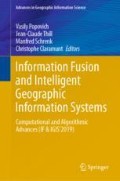Abstract
Adequate coverage is an important issue in geosensor networks in order to fulfill the sensing applications in urban areas. GIS as well as optimization methods are widely used to distribute geosensors in the network to achieve the desired level of coverage. Most of the algorithms applied in urban domain suffer from the lack of considering real environmental information. In this paper, the problem of placing sensors to get optimum coverage is studied by investigating the concept of urban contextual information in sensor network. Then a local GIS-based context-aware framework of sensor network deployment optimization method is introduced. Obtained results of our algorithm under different working conditions and applications show the effectiveness of our approach.
Access this chapter
Tax calculation will be finalised at checkout
Purchases are for personal use only
References
Nittel S (2009) A survey of geosensor networks: advances in dynamic environmental monitoring. Sensors (Basel) 9(7):5664–5678
Lewis FL (2004) Wireless sensor networks. Smart Environ Technol Protoc Appl 1–18
Ghosh A, Das SK (2008) Coverage and connectivity issues in wireless sensor networks: a survey. Pervasive Mob Comput 4(3):303–334
Ghosh A (2004) Estimating coverage holes and enhancing coverage in mixed sensor networks. In: 29th annual IEEE international conference on local computer networks, pp 68–76
Thai MT, Wang F, Du DH, Jia X (2008) Coverage problems in wireless sensor networks: designs and analysis. Int J Sens Netw 3(3):191–203
Li BM, Li Z, Vasilakos AV (2013) A survey on topology control in wireless sensor networks: taxonomy, comparative study, and open issues, vol 101, no 12
Aziz N, Aziz K, Ismail W (2009) Coverage strategies for wireless sensor networks. World Acad Sci Eng Technol 50:145–150
Ahmed N, Kanhere S, Jha S (2005) The holes problem in wireless sensor networks: a survey. ACM SIGMOBILE Mob Comput Commun Rev 1(2):1–14
Huang C, Tseng Y (2005) A survey of solutions to the coverage problems in wireless sensor networks. J Internet Technol 1:1–9
Adriaens J, Megerian S, Potkonjak M (2006) Optimal worst-case coverage of directional field-of-view sensor networks. In: 2006 3rd annual IEEE communications society on sensor and ad hoc communications and networks, pp 336–345
Akbarzadeh V, Gagne C, Parizeau M, Argany M, Mostafavi MA (2013) Probabilistic sensing model for sensor placement optimization based on line-of-sight coverage. IEEE Trans Instrum Meas 62(2):293–303
Argany M, Mostafavi MA, Karimipour F, Gagné C (2011) A GIS based wireless sensor network coverage estimation and optimization: a Voronoi approach. Trans Comput Sci XIV 6970:151–172
Paul AK, Sato T (2017) Localization in wireless sensor networks: a survey on algorithms, measurement techniques, applications and challenges. J Sens Actuator Netw 6(4)
Sun JZ, Sauvola J (2002) Towards a conceptual model for context-aware adaptive services. In: Proceedings of 8th international scientific and practical conference of students, post-graduates and young scientists modern technique and technologies MTT’2002 (Cat. No.02EX550), pp 90–94
Park S, Savvides A, Srivastava M (2000) SensorSim: a simulation framework for sensor networks. In: Proceedings of the 3rd ACM international workshop on modeling, analysis and simulation of wireless and mobile systems, pp 104–111
Mahfouz AMA, Hancke GP (2018) Localised information fusion techniques for location discovery in wireless sensor networks. Int J Sens Netw 26(1):12
Shit RC, Sharma S, Puthal D, Zomaya AY (2018) Location of Things (LoT): a review and taxonomy of sensors localization in IoT infrastructure. IEEE Commun Surv Tutorials 20(3):2028–2061
Bharathi Priya C, Sivakumar S (2018) A survey on localization techniques in wireless sensor networks. Int J Eng Technol 7(1.3):125
Karimipour F, Argany M, Mostafavi MA (2014) Spatial coverage estimation and optimization in geosensor networks deployment. In: Ibrahiem MM, Ramakrishnan S (eds) Wireless sensor networks, from theory to applications. CRC Press, Taylor & Francis Group, pp 59–83
Fan G, Jin S (2010) Coverage problem in wireless sensor network: a survey. J Netw 5(9):1033–1040
Argany M, Mostafavi MA, Akbarzadeh V, Gagne C, Yaagoubi R (2012) Impact of the quality of spatial 3D city models on sensor networks. Geomatica 66(4):291–305
Author information
Authors and Affiliations
Corresponding author
Editor information
Editors and Affiliations
Rights and permissions
Copyright information
© 2020 Springer Nature Switzerland AG
About this paper
Cite this paper
Argany, M., Mostafavi, MA. (2020). Develop a GIS-Based Context-Aware Sensors Network Deployment Algorithm to Optimize Sensor Coverage in an Urban Area. In: Popovich, V., Thill, JC., Schrenk, M., Claramunt, C. (eds) Information Fusion and Intelligent Geographic Information Systems . Advances in Geographic Information Science. Springer, Cham. https://doi.org/10.1007/978-3-030-31608-2_13
Download citation
DOI: https://doi.org/10.1007/978-3-030-31608-2_13
Published:
Publisher Name: Springer, Cham
Print ISBN: 978-3-030-31607-5
Online ISBN: 978-3-030-31608-2
eBook Packages: Earth and Environmental ScienceEarth and Environmental Science (R0)

